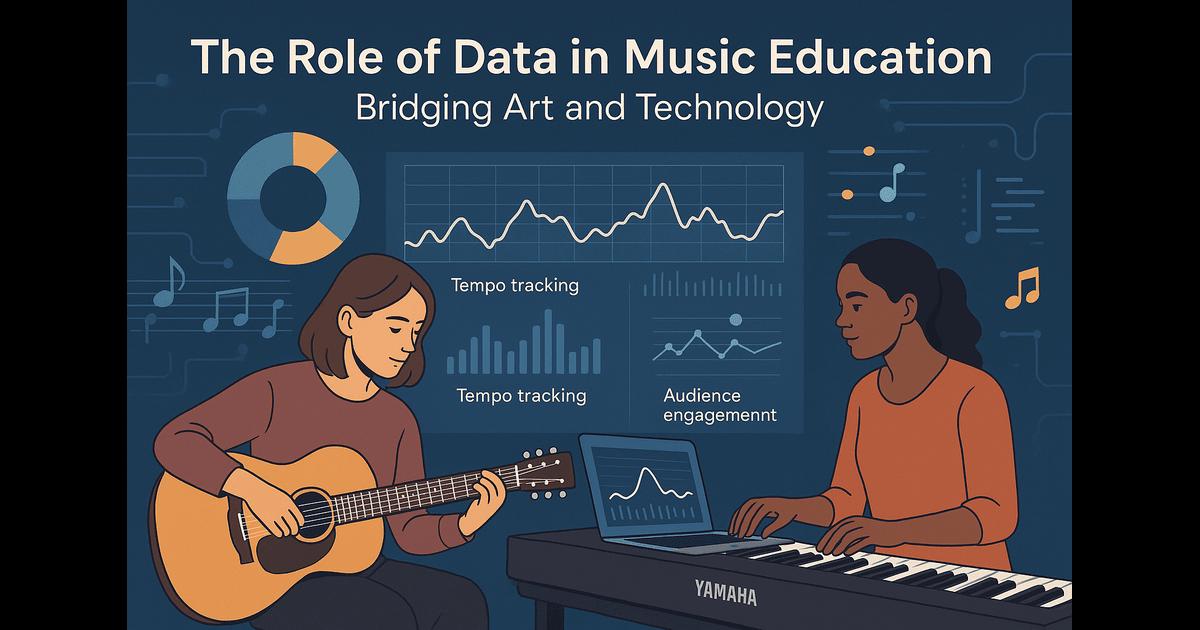Data in Music Education: Where Art Meets Technology
The conservatory used to be all about feel. You learned to listen. To replicate. To move an audience through tone, phrasing, and breath. But now, your practice sessions might be recorded, analyzed, and compared against thousands of hours of performance data. Today, data is reshaping how musicians learn and how they succeed.
This shift isn't about replacing artistry. It's about supporting it. Music education is still rooted in intuition and expression, but now it's layered with measurable feedback. Tempo tracking, audience engagement metrics, and even AI-assisted composition are all part of the toolkit.
And for many students juggling performance and sending occasional help me write my essay requests to deal with coursework, this tech-enhanced approach to learning offers something unexpected: clarity. Numbers that guide, not judge. Tools that support, not replace.
Music Education Is No Longer Just Analog
It's not rare anymore to see music majors logging into dashboards, reviewing pitch accuracy graphs or timing consistency heatmaps. Software like SmartMusic and Yousician gives students real-time corrections. DAWs like Logic and Ableton aren't just production tools; they're classroom essentials.
The shift is happening in classrooms, practice rooms, and living rooms.
Here's what data now informs in music education:
- Performance diagnostics
- Music theory comprehension
- Listening accuracy
- Ensemble synchronization
- Creative decision-making
This integration doesn't drain the emotion from music. It highlights where technique meets expression.
Data Gives Students a Feedback Loop They Can Trust
Traditional instruction often relies on subjective critique. Now, students can pair that with data-driven insights. Missed a beat? It's logged. Improved vibrato? Quantified. Instead of relying on memory or one-off comments, they see their growth mapped over time.
What makes this shift so powerful is the immediacy and precision of feedback:
- Students track their own progress daily
- Educators use data to spot trends early
- Lessons can be personalized to the student's pace
- Small technical issues don't get overlooked
In other words, data helps connect the dots: what you feel, what you hear, and what you see on the screen. When all three align, practice becomes performance-ready.
Composing for the Algorithm and the Audience
Music students aren't just performers anymore. They're analysts, producers, and strategists. Students study trends on Spotify and analyze how a song's structure affects engagement. Instructors now blend classical forms with coursework on algorithms, streaming analytics, and TikTok virality.
Because if you plan to release music today, you can't ignore the data. From genre tags to listener behavior, numbers shape discovery.
This new layer of learning includes:
- Reading audience heatmaps
- Understanding metadata in publishing
- Measuring emotional impact with engagement metrics
- Testing song structure against popular formats
The point isn't to write formulaic hits. It's to understand how creative choices affect how music lives and lasts in the world.
The Career Boost No One Warned You About
Here's the part most students don't expect: the data-savvy musician has a serious edge in the job market. Studios want interns who can edit tracks and run reports. Arts orgs want performers who understand digital branding. Even classical ensembles track performance metrics now.
Martin Buckley, an education expert from the essay writing service WriteMyEssay, says this trend is changing what music students need to know. "We still value ear training and theory, absolutely," he said. "But we're also asking: Can this student read audience data? Can they build a portfolio that resonates online? That's where the field is heading."
And he's right. Every student doesn't need to be a data scientist. But knowing how to use data to enhance your artistic choices? That's powerful.
Here are a few data-infused career paths opening up for music grads:
- Music analytics consultant
- Streaming platform curator
- Audio software tester
- Music data librarian
- Interactive music designer
Even traditional roles like educator or performer now benefit from tech fluency.
From Practice Rooms to Dashboards
Schools that embrace this fusion of art and analytics are building smarter programs. Students use tempo-mapping software to improve ensemble performance. Teachers review data reports before lessons. Composers run simulations to test how a piece builds tension.
This isn't about turning music into math. It's about giving musicians tools that sharpen their instincts.
Some schools are leading the way by:
- Integrating DAWs and MIDI software into first-year courses
- Offering electives in music business analytics
- Using student performance data to tailor ensemble roles
- Teaching social listening data as part of songwriting labs
The result? Students don't lose their voice. They find it faster.
What Educators Should Keep in Mind
As this shift unfolds, it's tempting to go all-in on the numbers. But good music education still starts with feeling, expression, and connection. Data is the support act, not the star.
Educators need to balance both worlds: teach the tools but also protect the space for imperfection, risk, and improvisation. That's still where magic happens.
And for students, the goal isn't perfect scores on software. It's to use those scores to dig deeper into their artistry. To know when they're locked in rhythm. To hear when a phrase lands. To trust that growth is real, because it's visible.
Conclusion: Finding Harmony Between Art and Tech
The role of data in music education isn't hypothetical. It's here, and it's changing how students learn, create, and launch careers.
From practice apps to streaming metrics, music students today have a layer of insight that previous generations could only dream of. When used well, it doesn't box creativity; it strengthens it. It gives musicians something rare: a roadmap, not just to better grades, but to better performances.

Premium music analytics, unbeatable price: $19.90/month
11M+ artists, 100M+ songs, 19M+ playlists, 6K+ festivals and 100K+ labels on one platform, built for industry professionals.


